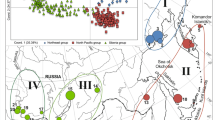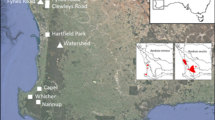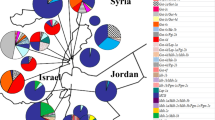Abstract
The main Korean mountain range that stretches from north to south (the Baekdudaegan) has been suggested to harbor an important glacial refugium for boreal and temperate plant species. Under this scenario, we expect high levels of within-population genetic variation and low or moderate degree of among-population differentiation within these species. To test this hypothesis, we examined clonal diversity and levels of allozyme diversity in the boreal Iris odaesanensis and in its temperate congener Iris rossii. In addition, we compiled data on boreal and temperate species whose distribution in the Korean Peninsula is mostly centered in the Baekdudaegan to determine if there is a common pattern. We found lower clonal diversity in I. odaesanensis compared to I. rossii. Both studied species maintained high levels of genetic variation as well as a moderate genetic differentiation (%P = 52.5 and 47.5, A = 1.70 and 1.58, H e = 0.158 and 0.150, and F ST = 0.196 and 0.189 for I. odaesanensis and I. rossii, respectively), in line with what occurs for the species distributed on the Baekdudaegan (n = 14, %P = 46.7, A = 1.73, H e = 0.161, and F ST = 0.190). This study strongly suggests that the Baekdudaegan may have acted as a refugium for boreal and temperate species, in a similar way to the southern Appalachians in the eastern United States.


Similar content being viewed by others
References
Adams JM, Faure H (1997) Review and atlas of palaeovegetation: preliminary land ecosystem maps of the world since the Last Glacial Maximum. Oak Ridge National Laboratory, Oak Ridge, Tennessee http://www.esd.ornl.gov/projects/qen/adams1.html. Accessed 23 June 2013
Arnaud-Haond S, Belkhir K (2007) GENCLONE: a computer program to analyze genotypic data, test for clonality and describe spatial clonal organization. Molec Ecol Notes 7:15–17
Arnaud-Haond S, Duarte CM, Alberto F, Serrão EA (2007) Standardizing methods to address clonality in population studies. Molec Ecol 16:5115–5139
Becheler R, Diekmann O, Hily C, Moalic Y, Arnaud-Haond S (2010) The concept of population in clonal organisms: mosaics of temporally colonized patches are forming highly diverse meadows of Zostera marina in Brittany. Molec Ecol 19:2394–2407
Birks HJB, Willis KJ (2008) Alpines, trees, and refugia in Europe. Pl Ecol Divers 1:147–160
Broyles SB (1998) Postglacial migration and the loss of allozyme variation in northern populations of Asclepias exaltata (Asclepiadaceae). Amer J Bot 85:1091–1097
Chang C-S, Kim H, Park T-Y (2003) Patterns of allozyme diversity in several selected rare species in Korea and implications for conservation. Biodivers Conservation 12:529–544
Chang C-S, Kim H, Park T-Y, Maunder M (2004) Low levels of genetic variation among southern peripheral populations of the threatened herb, Leontice microrhyncha (Berberidaceae) in Korea. Biol Conservation 119:387–396
Cheliak WM, Pitel JP (1984) Technique for starch gel electrophoresis of enzyme from forest tree species. Information Report PI-X-42. Petawawa National Forestry Institute, Agriculture Canada, Canadian Forestry Service, Chalk River
Choi K-R (1998) The post-glacial vegetation history of the lowland in Korean Peninsula. Korean J Ecol 21:169–174
Choi Y-K (2004) Baekdudaegan, the central axis of the Korean Peninsula—the path toward management strategies regarding to its concepts. In: Hong SK, Lee JA, Ihm B-S, Farina A, Son Y, Kim E-S, Choe JC (eds) Ecological issues in a changing world—status, response and strategy. Kluwer Academic Publishers, Dordrecht, pp 355–384
Chung MG, Epperson BK (1999) Spatial genetic structure of clonal and sexual reproduction in populations of Adenophora grandiflora (Campanulaceae). Evolution 53:1068–1078
Chung MG, Oh GS, Chung JM (1999) Allozyme variation in Korean populations of Taxus cuspidata (Taxaceae). Scand J Forest Res 14:103–110
Chung MG, Chung MY, Epperson BK (2001) Conservation genetics of an endangered herb, Hanabusaya asiatica (Campanulaceae). Pl Biol 3:42–49
Chung C-H, Lim HS, Yoon HI (2006) Vegetation and climate changes during the Late Pleistocene to Holocene inferred from pollen record in Jinju area, South Korea. Geosci J 10:423–431
Chung JM, Park KW, Park C-S, Lee S-H, Chung MG, Chung MY (2009) Contrasting levels of genetic diversity between the historically rare orchid Cypripedium japonicum and the historically common orchid Cypripedium macranthos in South Korea. Bot J Linn Soc 160:119–129
Chung MY, López-Pujol J, Maki M, Kim K-J, Chung JM, Sun B-Y, Chung MG (2012) Genetic diversity in the common terrestrial orchid Oreorchis patens and its are congener Oreorchis coreana: inference of species evolutionary history and implications for conservation. J Heredity 103:692–702
Chung MY, Chung JM, López-Pujol J, Park SJ, Chung MG (2013a) Genetic diversity in three species of Forsythia (Oleaceae) endemic to Korea: implications for population history, taxonomy, and conservation. Biochem Syst Ecol 47:80–92
Chung MY, Moon M-O, López-Pujol J, Chung JM, Chung MG (2013b) Genetic diversity in the two endangered endemic species Kirengesshoma koreana (Hydrangeaceae) and Parasenecio pseudotaimingasa (Asteraceae) from Korea: insights into population history and implications for conservation. Biochem Syst Ecol 51:60–69
Chung MY, Chung MG, López-Pujol J, Ren M-X, Zhang Z-Y, Park SJ (2014) Were the main mountain ranges in the Korean Peninsula a glacial refugium for plants? Insights from the congeneric pair Lilium cernuum—Lilium amabile. Biochem Syst Ecol 53:36–45
Clayton JW, Tretiak DN (1972) Amine citrate buffers for pH control in starch gel electrophoresis. J Fish Res Board Canad 29:1169–1172
Cornuet JM, Luikart G (1996) Description and power analysis of two tests for detecting recent population bottlenecks from allele frequency data. Genetics 144:2001–2014
Delcourt HR, Delcourt PA (1991) Quaternary ecology: a paleoecological perspective. Chapman & Hall, New York
Dorken ME, Eckert CG (2001) Severely reduced sexual reproduction in northern populations of a clonal plant, Decodon verticillatus (Lythraceae). J Ecol 89:339–350
El Mousadik A, Petit RJ (1996) High level of genetic differentiation for allelic richness among populations of the argan tree [Argania spinosa (L.) Skeels] endemic to Morocco. Theor Appl Genet 92:832–839
Eriksson O (1989) Seedling dynamics and life histories in clonal plants. Oikos 55:231–238
Eriksson O (1993) Dynamics of genets in clonal plants. Trends Ecol Evol 8:313–316
Godt MJW, Hamrick JL (1998a) Allozyme diversity in the endangered pitcher plant Sarracenia rubra ssp. alabamensis (Sarraceniaceae) and its close relative S. rubra ssp. rubra. Amer J Bot 85:802–810
Godt MJW, Hamrick JL (1998b) Allozyme diversity in the grasses. In: Cheplick GP (ed) Population biology in grasses. Cambridge University Press, Cambridge, pp 11–29
Godt MJW, Hamrick JL (2001) Genetic diversity in rare southeastern plants. Nat Areas J 21:61–70
Goudet J (1995) FSTAT (Version 1.2): a computer program to calculate F-statistics. J Heredity 86:485–486
Graham A (1999) Late Cretaceous and Cenozoic history of North American vegetation, north of Mexico. Oxford University Press, New York
Gustafson DJ, Guiunta AP, Echt CS (2013) Extensive clonal growth and biased sex ratios of an endangered dioecious shrub, Lindera melissifolia (Walt) Blume (Lauraceae). J Torrey Bot Soc 140:133–144
Hamrick JL, Godt MJW (1990) Allozyme diversity in plant species. In: Brown AHD, Clegg MT, Kahler AL, Weir BS (eds) Plant population genetics, breeding and genetic resources. Sinauer Associates, Sunderland, Massachusetts, pp 43–63
Hannan GL, Orick MW (2000) Isozyme diversity in Iris cristata and the threatened glacial endemic I. lacustris (Iridaceae). Amer J Bot 87:293–301
Hardy OJ, Vekemans X (2002) SPAGeDi: a versatile computer program to analyze spatial genetic structure at the individual or population level. Molec Ecol Notes 2:618–620
Harrison SP, Yu G, Takahara H, Prentice IC (2001) Diversity of temperate plants in east Asia. Nature 413:129–130
Haufler CH (1985) Enzyme variability and modes of evolution in Bommeria (Pteridaceae). Syst Bot 10:92–104
Hewitt GM (2000) The genetic legacy of the Quaternary ice ages. Nature 405:907–913
Highlands Biological Station (2013) Biodiversity of the Southern Appalachians. http://highlandsbiological.org/nature-center/biodiversity-of-the-southern-appalachians/. Accessed 5 Dec 2013
Hope G, Kershaw AP, van der Kaars S et al (2004) History of vegetation and habitat change in the Austral-Asian region. Quaternary Int 118–119:103–126
Hurlbert SH (1971) The nonconcept of species diversity: a critique and alternative parameters. Ecology 52:77–586
Jeong JH, Kim EH, Guo W, Yoo KO, Jo DK, Kim ZS (2010) Genetic diversity and structure of the endangered species Megaleranthis saniculifolia in Korea as revealed by allozyme and ISSR markers. Pl Syst Evol 289:67–76
Kaltenrieder P, Belis CA, Hofstetter S, Ammann B, Ravazzi C, Tinner W (2009) Environmental and climatic conditions at a potential Glacial refugial site of tree species near the Southern Alpine glaciers. New insights from multiproxy sedimentary studies at Lago della Costa (Euganean Hills, Northeastern Italy). Quaternary Sci Rev 28:2647–2662
Kim ZS, Lee SW, Lim JH, Hwang JW, Kwon KW (1994) Genetic diversity and structure of natural populations of Pinus koraiensis (Sieb. et Zucc.) in Korea. Forest Genet 1:41–49
Kim ZS, Hwang JW, Lee SW, Yang C, Gorovoy PG (2005) Genetic variation of Korean pine (Pinus koraiensis Sieb. et Zucc.) at allozyme and RAPD markers in Korea, China and Russia. Silvae Genet 54:235–246
Kong W-S, Watts D (1993) The plant geography of Korea with an emphasis on the alpine zones. Kluwer Academic Publishers, Dordrecht
Kron P, Stewart S, Back A (1993) Self-compatibility, autonomous self-pollination, and insect-mediated pollination in the clonal species Iris versicolor. Canad J Bot 71:1503–1509
Kudoh H, Shibaike H, Takasu H, Whigham DF, Kawano S (1999) Genet structure and determinants of clonal structure in a temperate deciduous woodland herb, Uvularia perfoliata. J Ecol 87:244–257
Langella O (1999) Populations 1.2.30 [computer program]. http://bioinformatics.org/~tryphon/populations/. Accessed 5 Mar 2013
Legendre P, Lapointe F-J, Casgrain P (1994) Modeling brain evolution from behavior: a permutational regression approach. Evolution 48:1487–1499
Lim D-O (2003) Vascular plants of mountain ridge from Cheonwangbong-Hyangjeokbong section in the Baekdudaegan. Korean J Environm Ecol 16:359–386 (In Korean with English abstract)
Liu Z-C, Jiao Z-J, Dong X-S, Dai J-X (2011) Floral syndrome and breeding system of Iris tectorum. Acta Hort Sin 38:1333–1340 (in Chinese with English abstract)
Luikart G, Allendorf FW, Cornuet JM, Sherwin WB (1998) Distortion of allele frequency distributions provides a test for recent population bottlenecks. J Heredity 89:238–247
Ministry of Environment (2005) Wildlife protection act. Ministry of Environment, Gwacheon (in Korean)
Mitton JB, Linhart YB, Sturgeon KB, Hamrick JL (1979) Allozyme polymorphisms detected in mature needle tissue of ponderosa pine. J Heredity 70:86–89
Nei M (1973) Analysis of gene diversity in subdivided populations. Proc Natl Acad Sci USA 70:3321–3323
Nei M (1978) Estimation of average heterozygosity and genetic distance from a small number of individuals. Genetics 89:583–590
Nei M, Maruyama T, Chakraborty R (1975) The bottleneck effect and genetic variability in populations. Evolution 29:1–10
Nei M, Tajima F, Tateno Y (1983) Accuracy of estimated phylogenetic trees from molecular data. II. Gene frequency data. J Molec Evol 19:153–170
Nieto Feliner G (2011) Southern European glacial refugia: a tale of tales. Taxon 60:365–372
Ohsako T (2010) Clonal and spatial genetic structure within populations of a coastal plant, Carex kobomugi (Cyperaceae). Amer J Bot 97:458–470
Page RDM (1996) TreeView: an application to display phylogenetic trees on personal computers. Comput Appl Biosci 12:357–358
Parker KC, Hamrick JL (1992) Genetic diversity and clonal structure in a columnar cactus, Lophocereus schottii. Amer J Bot 79:86–96
Parks JC, Werth CR (1993) A study of spatial features of clones in a population of bracken fern, Pteridium aquilinum (Dennstaedtiaceae). Amer J Bot 80:537–544
Pielou EC (1969) An introduction to mathematical ecology. Wiley, New York
Prentice IC, Harrison SP, Bartlein PJ (2011) Global vegetation and terrestrial carbon cycle changes after the last ice age. New Phytol 189:988–998
Rousset F (1997) Genetic differentiation and estimation of gene flow from F-statistics under isolation by distance. Genetics 145:1219–1228
Rull V (2009) Microrefugia. J Biogeogr 36:481–484
Sapir Y, Shmida A, Ne’eman G (2005) Pollination of Oncocyclus irises (Iris: Iridaceae) by night-sheltering male bees. Pl Biol 7:417–424
Simonich MT, Morgan MD (1994) Allozymic uniformity in Iris lacustris (dwarf lake iris) in Wisconsin. Canad J Bot 72:1720–1722
Soltis DE, Haufler CH, Darrow DC, Gastony GJ (1983) Starch gel electrophoresis of ferns: a compilation of grinding buffers, gel and electrode buffers, and staining schedules. Amer Fern J 73:9–27
Soltis DE, Morris AB, McLachlan JS, Manos PS, Soltis PS (2006) Comparative phylogeography of unglaciated eastern North America. Molec Ecol 15:4261–4293
Sutherland WJ (1990) Biological flora of the British Isles: Iris pseudacorus L. J Ecol 78:833–848
Uno GE (1982) The influence of pollinators on the breeding system of Iris douglasiana. Amer Midl Naturalist 108:149–158
van der Bank H, van der Bank M, van Wyk B-E (2001) A review of the use of allozyme electrophoresis in plant systematic. Biochem Syst Ecol 29:469–483
Wang Z-F, Hamrick JL, Godt MJW (2004) High genetic diversity in Sarracenia leucophylla (Sarraceniaceae), a carnivorous wetland herb. J Heredity 95:234–243
Watts S, Sapir Y, Segal B, Dafni A (2013) The endangered Iris atropurpurea (Iridaceae) in Israel: honey-bees, night-sheltering male bees and female solitary bees as pollinators. Ann Bot (Oxford) 111:395–407
Weeden NF, Wendel JF (1989) Genetics of plant isozymes. In: Soltis DE, Soltis PS (eds) Isozymes in plant biology. Dioscorides Press, Portland, pp 46–72
Weir BS, Cockerham CC (1984) Estimating F-statistics for the analysis of population structure. Evolution 38:1358–1370
Whitehead FH (1971) Comparative autecology as a guide to plant distribution. In: Duffey EO, Watt AS (eds) The scientific management of animal and plant communities for conservation: Proceedings of the 11th Symposium of the British Ecological Society, 1970 July 7–9. Blackwell Scientific Publications, Norwich, pp 167–176
Williams JW, Webb T III, Richard PH, Newby P (2000) Late Quaternary biomes of Canada and the eastern United States. J Biogeogr 27:585–607
Wilson GA, Rannala B (2003) Bayesian inference of recent migration rates using multilocus genotypes. Genetics 163:1177–1191
Wright S (1965) The interpretation of population structure by F-statistics with special regard to systems of mating. Evolution 19:395–420
Yeh FC, Yang RC, Boyle TBJ (1999) POPGENE version 1.32, Microsoft Window-based free ware for population genetic analysis. http://www.ualberta.ca/~fyeh/index.htm. Accessed 14 Mar 2013
Zhao Y, Noltie HJ, Mathew B (2000) Iridaceae. In: Wu ZY, Raven PH, Hong DY (eds) Flora of China, vol 24. Flagellariaceae through MarantaceaeScience Press, Beijing and Missouri Botanical Garden Press, St. Louis, pp 297–313
Zheng YQ, Qian ZC, He HR, Liu HP, Zeng XM, Yu G (2007) Simulations of water resource environmental changes in China during the last 20,000 years by a regional climate model. Glob Planet Change 55:284–300
Acknowledgments
We thank Beom Jin Shim and Myeong Soon Park for laboratory assistance, and Dr. Yeon Bong Gu for helping us in locating populations of I. odaesanensis. This research was supported in part by the National Institute of Biological Resources, Republic of Korea to M.G. C. and Basic Science Program through the National Research Foundation of Korea (NRF-2013R1A1A3010892) funded by the Ministry of Education, Science and Technology, the Republic of Korea to M.Y.C.
Author information
Authors and Affiliations
Corresponding author
Additional information
Handling editor: Pablo Vargas Gomez.
Rights and permissions
About this article
Cite this article
Chung, M.Y., López-Pujol, J., Lee, Y.M. et al. Clonal and genetic structure of Iris odaesanensis and Iris rossii (Iridaceae): insights of the Baekdudaegan Mountains as a glacial refugium for boreal and temperate plants. Plant Syst Evol 301, 1397–1409 (2015). https://doi.org/10.1007/s00606-014-1168-8
Received:
Accepted:
Published:
Issue Date:
DOI: https://doi.org/10.1007/s00606-014-1168-8




